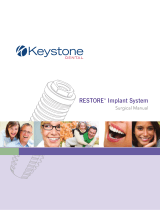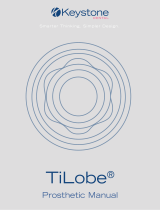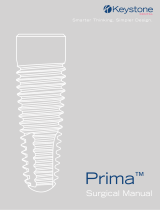1/3
en - Instrucon for use - Anthogyr Mini Implant
K
A Anthogyr
2237 Av. André Lasquin
74700 Sallanches – France
Phone : +33(0)4 50 58 02 37
www.anthogyr.com
Validity Date : 2021-03
REF : 063IMPL-MIO_NOT
Index : A
1. Product descripon
Anthogyr Mini Implant is a single-component
implant with an Oploc® prosthec connecon.
The Anthogyr Mini Implant system includes ins-
truments and prosthec and surgical parts.
Anthogyr Mini Implants are implants with a
sandblasted BCP bone anchoring surface and a
DLC (a-C:H) coated connecon.
The Oploc® matrix system is a prefab connetor
for the retenon of removable restoraons on
Anthogyr Mini Implants. The Oploc® matrix is
made of a housing and interchangeable plasc
(PEEK) retenon inserts with dierent colour-
coded retenon values or extracon forces.
These instrucons for use are valid for the follo-
wing dental implants:
- Anthogyr Mini Implants
Materials:
Titanium-6aluminium-4vanadium alloy:
2. Intended use
Anthogyr Mini Implants are intended for the
replacement of missing tooth roots and allows
the stabilisaon of removable full dentures.
3. Indicaons
Anthogyr Mini Implants are indicated for the
stabilisaon of complete removable dentures in
the mandible and/or maxilla with a total eden-
tulousness.
They allow immediate loading in an appropriate
clinical situaon (good primary stability).
4. Clinical benets
- Stabilisaon of removable prosthesis
- Restoraon of mascatory funcon
- Aesthec restoraon
5. Paent type and intended user
Anthogyr Mini Implants are intended for use
with parally or totally edentulous adult pa-
ents who do not present any of the condions
menonned in the “contraindicaons”secon.
Anthogyr Mini Implants must be used by a sur-
geon trained in dental implantology.
6. Contraindicaons
Anthogyr Mini Implants are contraindicated in
following cases:
- Implant divergence greater than 40° between
two implants.
- D4 bones .
- Allergy or hypersensivity to chemical com-
ponents in the materials used and menoned in
the “Product descripon” secon.
- Absolute contraindicaons: serious diseases
(tumours, heart disease, etc.), metabolism disor-
ders, uncompensated haematologic diseases,
drug addion, alcoholism, psychosis, funconal
disorders, xerostomia, immune deciency, leu-
kocyte disorder, local or systemic treatments
(steroid, ancoagulant, chemotherapy or radia-
on therapy, etc.).
- Relave contraindicaons: bruxism, occlusal
stress, parafuncon, unfavourable bone anato-
my, pregnancy, growth not nished, insucient
oral hygiene, smoking lack of movaon or
cooperaon, irradiated bone, uncontrolled pe-
riodontal disease, oral infecons or inamma-
ons.
- Localised contraindicaons: Excessive resorp-
on and/or insucient bone quality, local radi-
cular residues.
7. Warning
Implant surgery is a complex dental procedure.
Incorrect techniques can cause implant failure
and/or loss of bone support.
Appropriate training and qualicaon and a
good knowledge of surgical techniques with
Anthogyr products are required. Anthogyr oers
specic training.
8. Cauon/precauons
Clinical use:
Single-use devices: do not reuse or re-sterilise.
Risk of contaminaon and risk of alteraon of
the funconal surfaces.
It is important to perform a pre-clinical as-
sessment and treatment plan that takes into
account the anatomical constraints of the future
restoraon.
Do not use an implant aer the expiry date indi-
cated on the packaging
Safety informaon regarding magnec re-
sonance imaging (MRI):
The safety and compability of Anthogyr devices
that remain in the paent’s body have not been
evaluated in the magnec resonance (MR) envi-
ronment. They have not been tested for heat
build-up, migraon or artefacts in MR environ-
ments. The safety of Anthogyr devices in an MR
environment is unknown. Performing an MRI
examinaon on a paent wearing such a device
may result in injuries.
9. Unwanted side eects
The clinical outcome of dental treatment is in-
uenced by mulple factors. The following resi-
dual risks and possible side eects are related to
the use of Anthogyr Mini Implant and may lead
to addional dental treatment at the dental
pracce: swelling, haematoma, risk of swallo-
wing/inhaling small parts during the procedure,
phonec problems, pain, hypersensivity/
allergic reacons, inadequate funcon or device
failure (mobility, loss of integrity), aesthec
problems, gingival injuries, damage to exisng
denon, bone damage, loss of marginal bone,
hyperplasia, exfoliaon, dysesthesia, post-
surgical paraesthesia, perforaon of sinus or
alveolar plates, systemic or local infecon
(including peri-implans, periodons, gingivi-
s, stula), local or systemic infecons including
bacterial endocardis.
10. Compability informaon
Anthogyr Mini Implants must be used in combi-
naon with the corresponding Oploc® system
components and Oploc® compable over-
dentures.
Only use original parts with the Oploc® connec-
on to place Anthogyr Mini Implants. If unsui-
table ancillary equipment is used: risk of injury,
damage and malfuncon of the implant, risk of
damage to the ancillary equipment.
For more informaon, please refer to the ma-
nuals listed in the “Further informaon” secon.
11. Cleaning and disinfecon
Anthogyr Mini Implants are supplied sterile
(GAMMA sterilisaon) and are intended for
single use. Do not clean or sterilise the implants.
Cleaning, disinfecon and sterilisaon can com-
promise the essenal material and design fea-
tures of the implants and result in device failure.
12. Sterilisaon
Anthogyr dental implants are supplied sterile.
Check that the enre packaging of the device is
undamaged before opening. Implant with a da-
maged packaging must not be used. It is recom-
mended to have a replacement implant readily
available for use. The intact blister pack protects
the sterilised implant against any external in-
uence and, if stored properly, guarantees steri-
lity unl the expiry date. The blister pack must
not be opened before implant use. When remo-
ving the implant from the sterile packaging,
asepsis rules must be followed.
Anthogyr declines all responsibility for re-
sterilised implants, regardless of who carried out
the re-sterilisaon or the method used. Under
no circumstances should a previously used or
Chemical components Composion, %
(mass/mass)
Aluminium 5.50 to 6.50
Vanadium 3.50 to 4.50
Other (Fe, O, C, N, H) Total max 0.53
Titanium Balance
Type of
implant
Type of
connecon
Compable
components
Anthogyr Mini
implant Oploc® Oploc®
Compable instruments
Oploc® screwing instruments included in the
kit.















